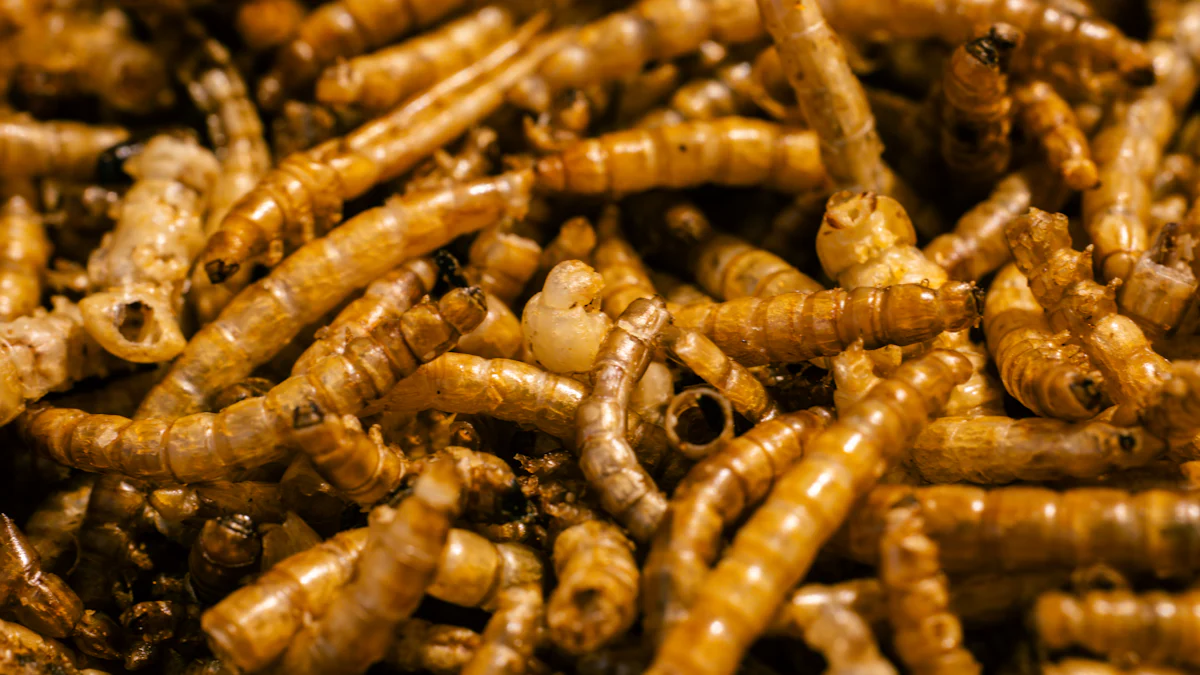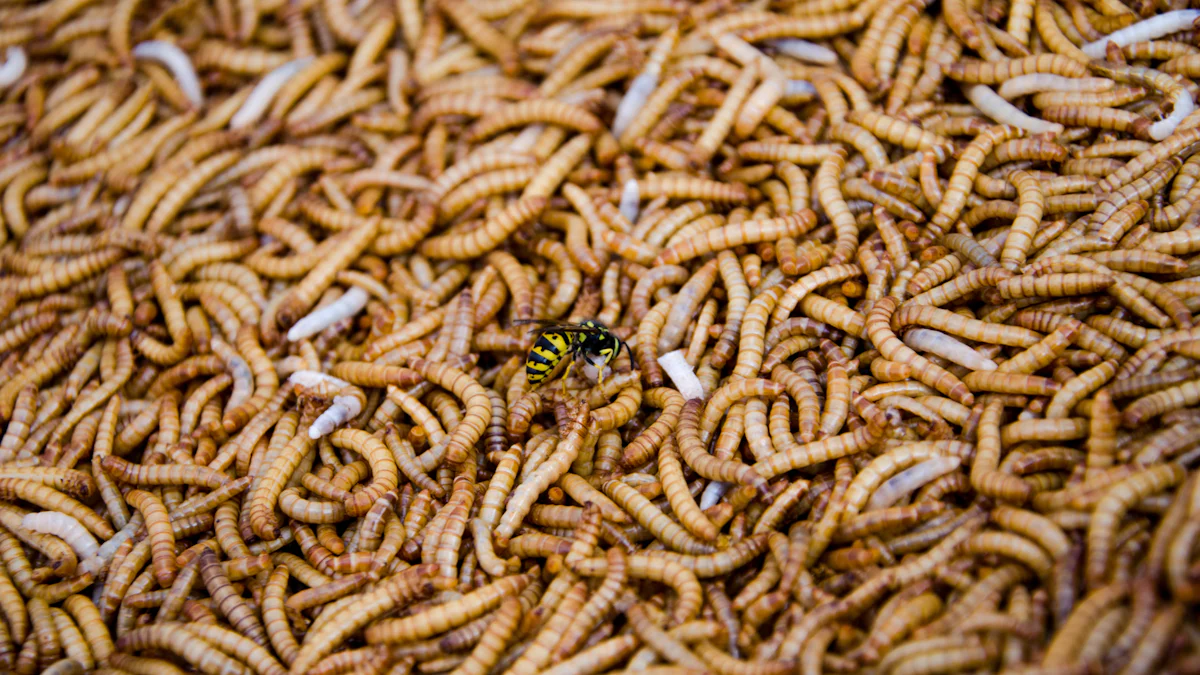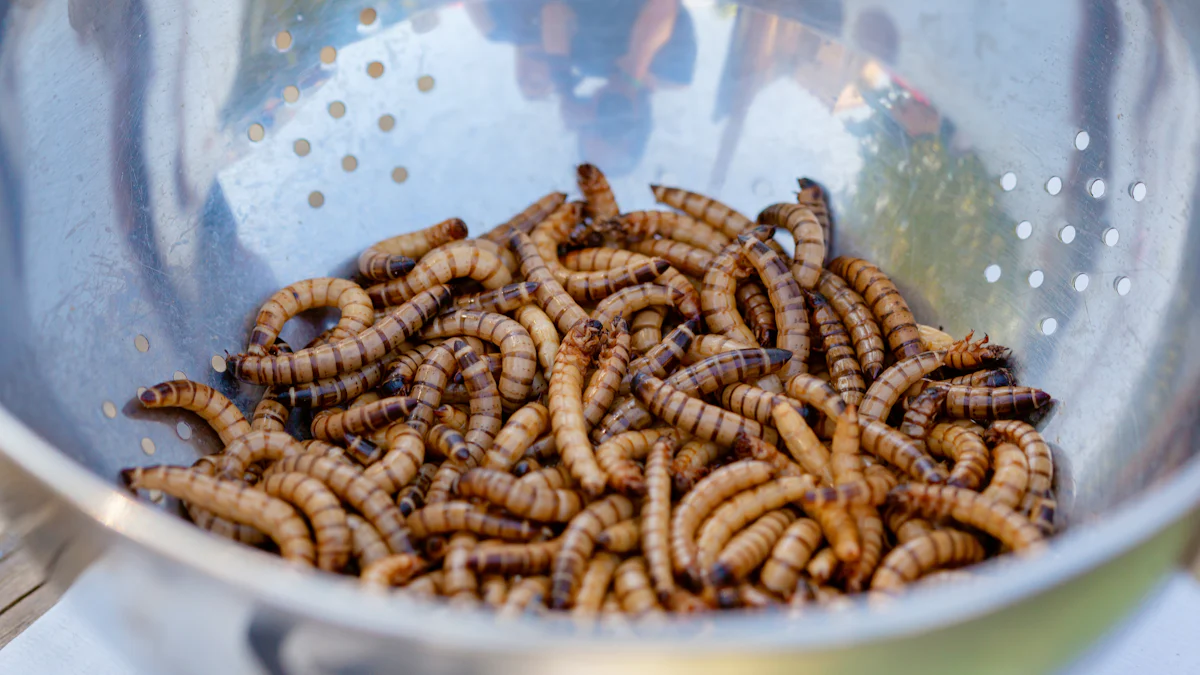
Feeding mealworms to fish is a fantastic way to provide them with a nutritious food source. Packed with protein, fats, and essential nutrients, mealworms help your fish thrive. Advances in farming have made mealworms more eco-friendly. Farmers now use mesh trays to protect eggs, water gel crystals for moisture, and mealworm frass to enrich soil. Cichlids especially love feeding on them!
Key Takeaways
- Mealworms have a lot of protein, from 20% to 76%. This helps fish grow and build strong muscles.
- Mealworms improve fish health with important fats and nutrients. They have omega-3, omega-6, vitamins, and minerals.
- Giving mealworms lets fish act naturally by searching for food. This lowers stress and keeps their minds active.
Nutritional Benefits of Feeding Mealworms to Fish

High Protein Content for Enhanced Growth
Mealworms are a powerhouse of protein, making them an excellent choice for your fish’s diet. Depending on their diet and stage of development, mealworms can contain anywhere from 20% to 76% protein. This is significantly higher than many traditional fish feeds. For example, mealworms provide about 50-60% protein by dry weight, which is essential for fish growth and muscle development. Whether you’re raising koi, cichlids, or goldfish, this protein boost helps your fish grow faster and stay healthier.
Young fish, in particular, benefit from this high protein content as it supports their rapid growth phases. By feeding mealworms to fish, you’re giving them the building blocks they need to thrive.
Rich in Healthy Fats and Essential Nutrients
Mealworms aren’t just about protein—they’re also packed with healthy fats and other nutrients. They contain omega-3 and omega-6 fatty acids, which are crucial for fish health. These fats improve the quality of fish flesh and eggs, making them ideal for breeding fish. Mealworms also provide a range of vitamins and minerals, including B vitamins, calcium, phosphorus, and iron. These nutrients strengthen your fish’s immune system and promote overall well-being.
Interestingly, the fat composition of mealworms varies based on their diet. For instance, mealworms fed on wheat bran contain about 31-42% oleic acid and 28% linoleic acid, both of which are beneficial for fish. This makes them a versatile and nutrient-rich food source.
Supports Natural Foraging and Enrichment
Feeding mealworms to fish does more than just nourish them—it also keeps them mentally stimulated. Many fish, like koi and cichlids, are natural foragers. Offering mealworms encourages them to hunt and search for food, mimicking their behavior in the wild. This activity reduces boredom and stress, especially in captive environments like aquariums or ponds.
When fish engage in natural foraging, they stay active and alert, which improves their overall health. Mealworms are a great way to enrich your fish’s environment while providing them with a tasty and nutritious treat.
Benefits for Different Types of Fish

Koi and Pond Fish: Boosting Color and Vitality
Mealworms are a fantastic addition to the diet of koi and other pond fish. They’re packed with carotenoids, which help enhance the vibrant yellow, red, and orange colors of koi. If you want your fish to stand out, mealworms can make a noticeable difference. You can even combine them with other natural color-enhancing foods for an even brighter effect.
Mealworms also provide a great energy boost, especially during colder months when fish need extra nutrition. Their 28% lipid content mimics the natural prey koi would eat in the wild. This keeps your fish active and healthy. Plus, dried mealworms are loaded with essential nutrients like fatty acids, vitamins B12 and D, and minerals like calcium and phosphorus. These nutrients improve skin and scale health, making your fish look their best.
Tropical Freshwater Fish: A Treat for Cichlids and Goldfish
Tropical freshwater fish, like cichlids and goldfish, love mealworms. They’re a rich source of protein and fats, which are essential for their growth and vitality. Cichlids, in particular, are insect lovers. Feeding mealworms to fish like cichlids stimulates their natural feeding behaviors and keeps them engaged.
Goldfish also benefit from the variety mealworms bring to their diet. These little treats provide enrichment and mimic the natural foraging habits of fish in the wild. Just remember to offer mealworms in moderation and ensure they’re gut-loaded for maximum nutritional value.
Saltwater Fish: Enhancing Marine Diets
Saltwater fish can also enjoy the benefits of mealworms. They’re highly palatable, making them an attractive food option for many marine species. Carnivorous fish, like bettas and cichlids, thrive on the high protein content mealworms offer. These fish have digestive systems adapted to handle protein-rich diets, so mealworms fit right in.
However, it’s important to feed mealworms in moderation. While they’re nutritious, overfeeding can lead to long-term issues. For herbivorous species, mealworms may not be as beneficial, so it’s best to pair them with other foods that suit their dietary needs.
Feeding Guidelines and Best Practices for 2025
Sustainable Sourcing and Home-Raised Mealworms
Mealworms are an eco-friendly choice for feeding fish. They require minimal land, water, and nutrients to grow, making them a sustainable alternative to traditional protein sources. Their high feed conversion rates mean they produce more protein with fewer resources. This aligns perfectly with the growing demand for environmentally conscious food options in 2025.
If you want to raise mealworms at home, it’s easier than you think! Keep their environment humid—around 70% is ideal—and feed them organic scraps like cabbage or apples. This not only reduces waste but also ensures your mealworms are nutrient-rich. Use a mesh screen to harvest them when they’re ready. Regularly check their moisture levels to prevent mold or cannibalism. Home-raised mealworms are a great way to control quality while saving money.
Feeding Frequency and Portion Control
When feeding mealworms to fish, moderation is key. For most species, mealworms should make up about 10-15% of their diet. Koi, for example, enjoy mealworms as a treat during warmer months. Tropical fish like cichlids benefit from smaller, cut-up portions. Always monitor your fish for signs of overfeeding or digestive issues. A varied diet is essential, so don’t rely solely on mealworms.
Combining Mealworms with Other Foods for Balance
Mealworms are a fantastic protein source, but balance is crucial. Pair them with other insect-based foods or gut-load them with nutrient-rich vegetables before feeding. This enhances their nutritional value. Freshly molted mealworms are easier for fish to digest, so consider offering these for better results. Combining mealworms with plant-based foods ensures your fish get a well-rounded diet that supports their health and growth.
Feeding mealworms to fish in 2025 is a win-win for you and the environment. These little insects pack a punch with their protein, fats, and nutrients, keeping your fish healthy and happy. Plus, they’re a sustainable choice. Mealworms reduce reliance on fish meal, cut down on energy use, and even support local aquaponic systems.
Mealworms are versatile too. They’re easy to farm, require less water and space, and can even thrive on organic waste. This makes them a smart option for eco-conscious fish keepers like you. By adding mealworms to your fish’s diet, you’re not just promoting their well-being—you’re also helping the planet.
Tip: Cichlids especially love mealworms. These insect lovers enjoy the enrichment and nutrition mealworms bring to their tank.
FAQ
Can all fish eat mealworms?
Most fish enjoy mealworms as a treat. Cichlids, koi, and goldfish love them. However, herbivorous fish may not benefit as much from their high protein content.
Should I feed live or dried mealworms?
Both options work! Live mealworms encourage natural foraging, while dried ones are convenient and long-lasting. Choose based on your fish’s preferences and your feeding routine.
How do I prepare mealworms for my fish?
Cut larger mealworms into smaller pieces for small fish. Gut-load them with vegetables for extra nutrients. Freshly molted mealworms are softer and easier to digest.


